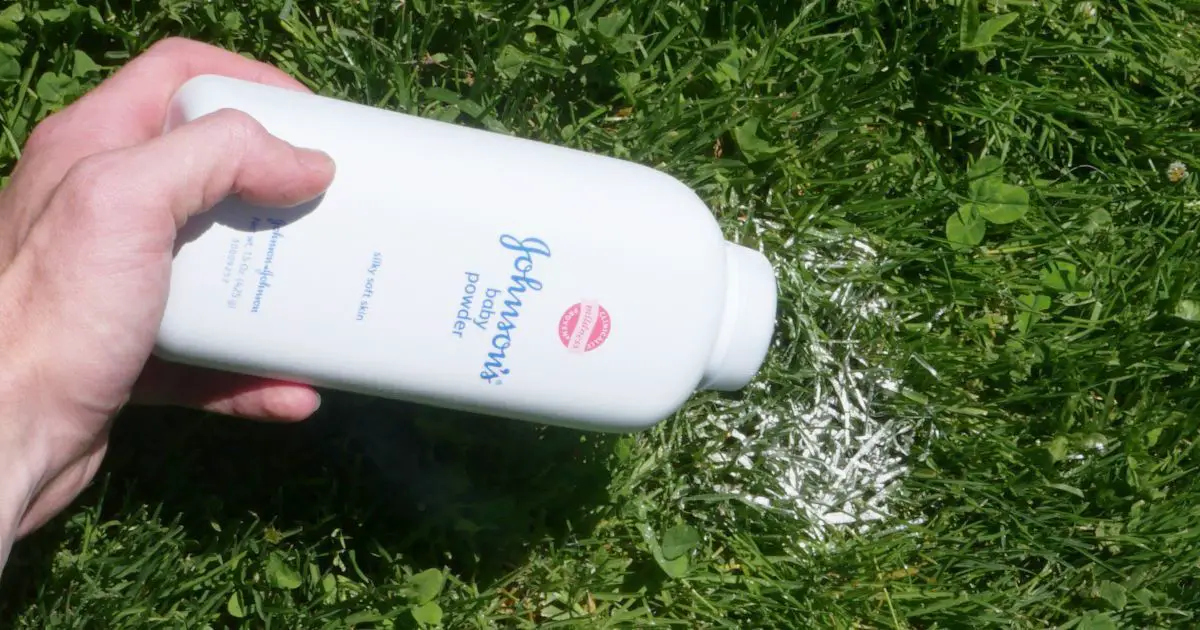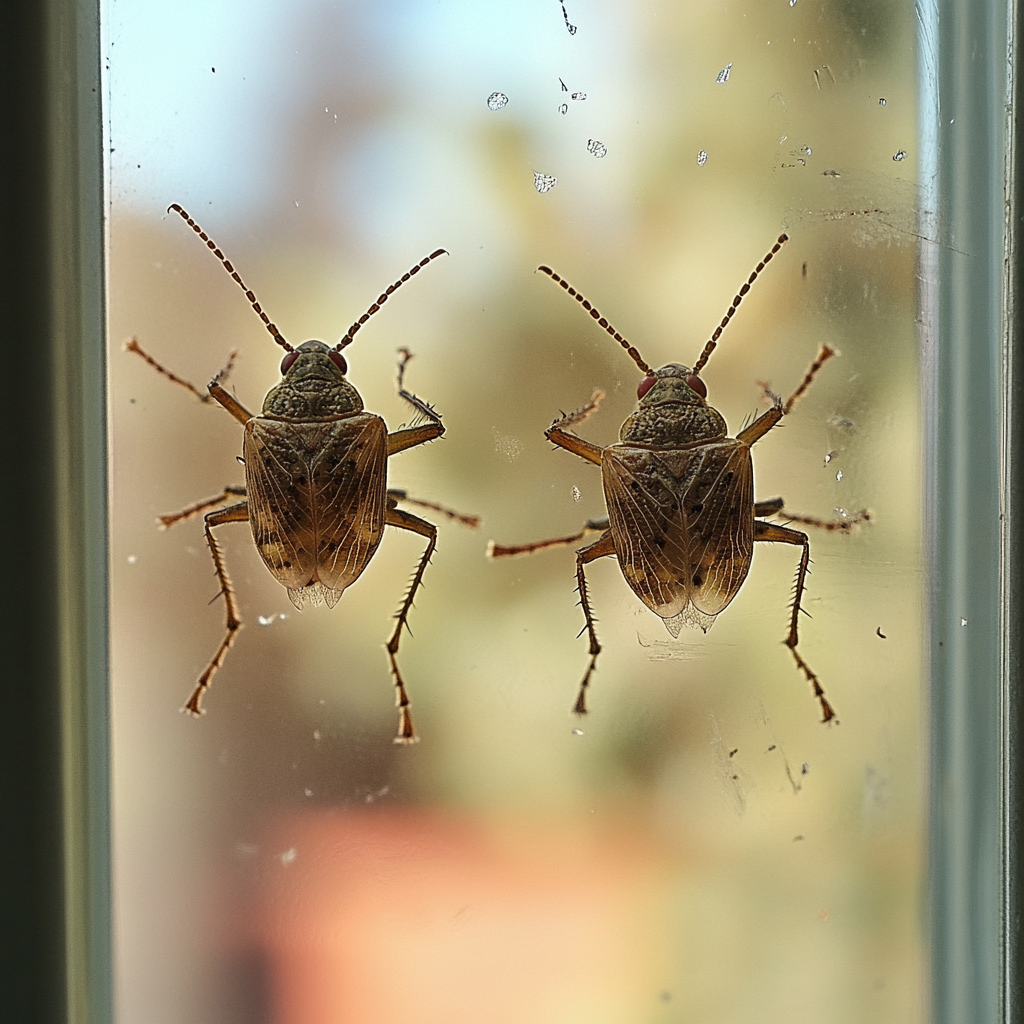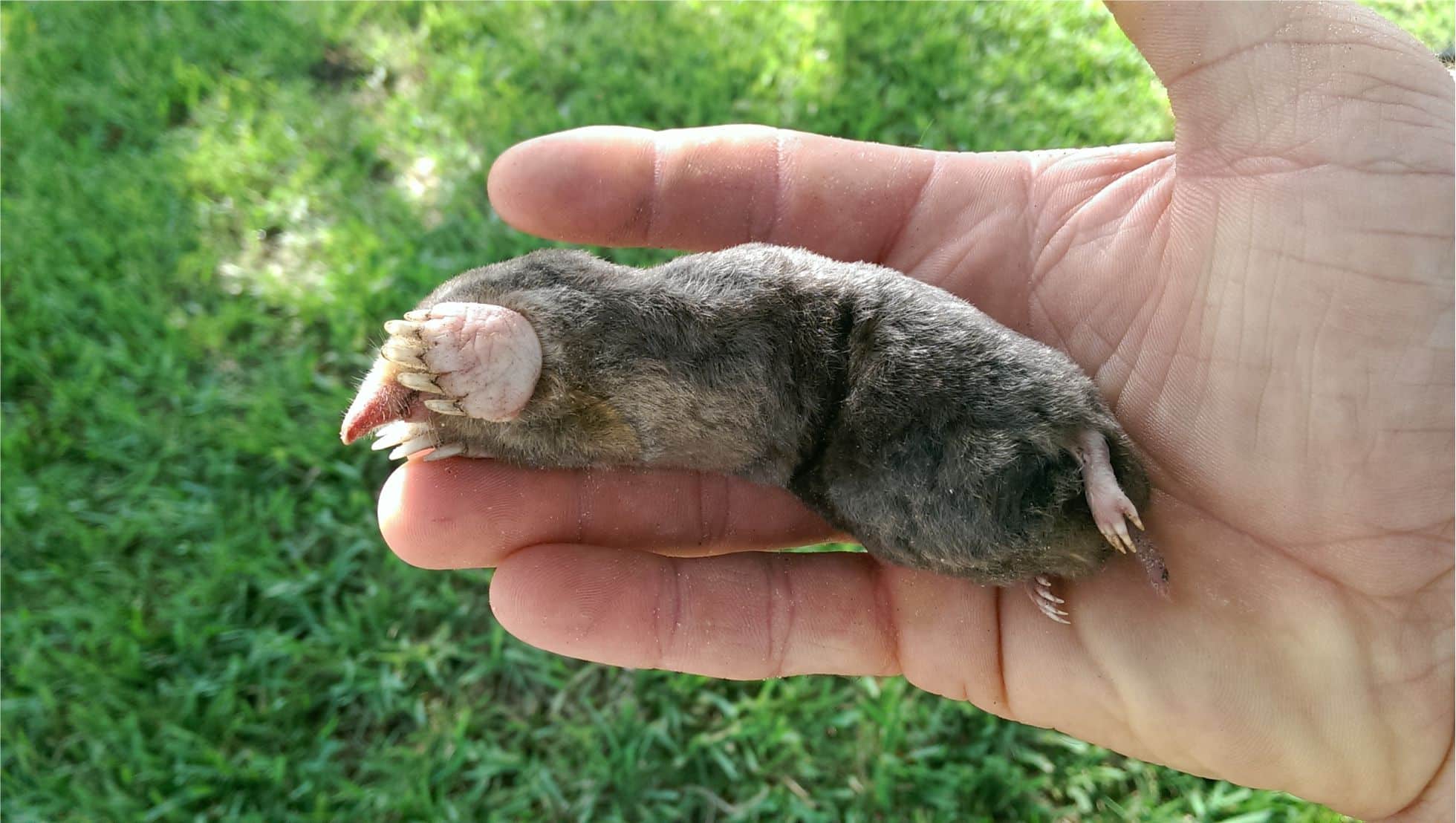Hyacinth flowers (Hyacinthus orientalis) bring a strong scent to spring gardens. Their bright, tubular flowers and strap-shaped leaves stand out.
Introduced in Europe in the 16th century, they quickly became popular, leading to over 2,000 varieties by the 18th century. Today, about 60 types are grown commercially.
Hyacinths are easy to grow and will come back every year. However, their blooms may not be as strong after a few years. They thrive when planted in the fall and grow at a moderate pace.
Hyacinths can be grown outdoors or in pots. They also do well in a bulb vase with water indoors. But remember, keep them away from kids and pets as the bulbs are toxic.

Key Takeaways
- Hyacinths are easy-to-grow perennial spring bulbs with a powerful, pleasant fragrance.
- Hyacinth bulbs should be planted in the fall, 4-6 inches deep and 3-6 inches apart.
- Hyacinths prefer well-drained, slightly acidic to neutral soil and full sun to partial shade.
- Hyacinth bulbs are toxic to humans and pets, so keep them out of reach.
- Hyacinths typically bloom in mid-spring and can be forced for early indoor displays.
Hyacinth Overview and Care Requirements
When people talk about “hyacinth,” they often mean both the Hyacinthus and Muscari genera. These plants look similar and need similar care, so they share a name. Hyacinths are perennials that grow 6-12 inches tall and 3-6 inches wide. They belong to the Asparagaceae family.
What is a Hyacinth?
Hyacinths are famous for their bright, fragrant flowers that bloom in spring. You can find them in many colors like white, blue, purple, pink, and red.
These bulbs grow in USDA zones 4-8 and come from Southwestern Asia. But, it’s key to keep them away from pets and kids because they’re toxic.
Basic Care Needs
Hyacinths do best in soil that’s a bit acidic to neutral, loose, moist, and drains well. Plant them in the fall, 4-6 inches deep, and 3-6 inches apart. They need about 1/2 inch of water each week, either from rain or a hose.
They also do well with a special bulb fertilizer in the fall and again when they start growing in spring. Make sure the soil drains well to stop the bulbs from rotting in wet, cool spots.
| Hyacinth Characteristic | Description |
|---|---|
| Botanical Name | Hyacinthus |
| Family | Asparagaceae |
| Plant Type | Perennial Bulb |
| Mature Size | 6-12 inches tall, 3-6 inches wide |
| Sunlight Requirements | Full Sun |
| Soil Preferences | Well-drained, slightly acidic to neutral |
| Bloom Time | Early to Mid-Spring |
| Flower Color | White, Blue, Purple, Pink, Red |
| Hardiness Zones | 4-8 |
| Native Area | Southwestern Asia |
| Toxicity | Toxic to Humans, Pets |
How To Grow A Hyacinth and Care
Planting Hyacinth Bulbs
The best time to plant hyacinth bulbs is in the fall, from October to December. This is about six to eight weeks before the first frost. Place the bulbs root-end down, 4-6 inches deep, and 3-6 inches apart. For containers, you can plant them closer together, making sure they have enough soil space.
After planting, cover the bulbs with soil and water well. In colder areas, plant the bulbs a bit deeper, around 6-7 inches, for extra insulation during winter.
Hyacinth Growing Conditions
Hyacinths do well in full sun to partial shade, needing 6-8 hours of sunlight daily. They like soil that’s slightly acidic to neutral, with a pH of 6.0-7.0. The soil should be loose and drain well to prevent rot in cool, wet spots.
Water new hyacinth plants well, then let the soil dry out a bit before watering again. Try to give them about 1/2 inch of water each week, from rain or irrigation.
In cold areas, cover the bulbs with mulch for protection. In warmer places, you might need to dig up the bulbs, chill them, and replant for blooming.
| Hyacinth Care Requirement | Optimal Condition |
|---|---|
| Planting Depth | 4-6 inches (6-7 inches in colder climates) |
| Bulb Spacing | 3-6 inches apart (5-6 inches for outdoor planting) |
| Sunlight Needs | Full sun to partial shade (6-8 hours of direct sunlight) |
| Soil pH | Slightly acidic to neutral (6.0-7.0) |
| Watering Requirements | About 1/2 inch of water per week |
| Winter Protection | Mulch in colder climates, dig up and chill in warmer regions |
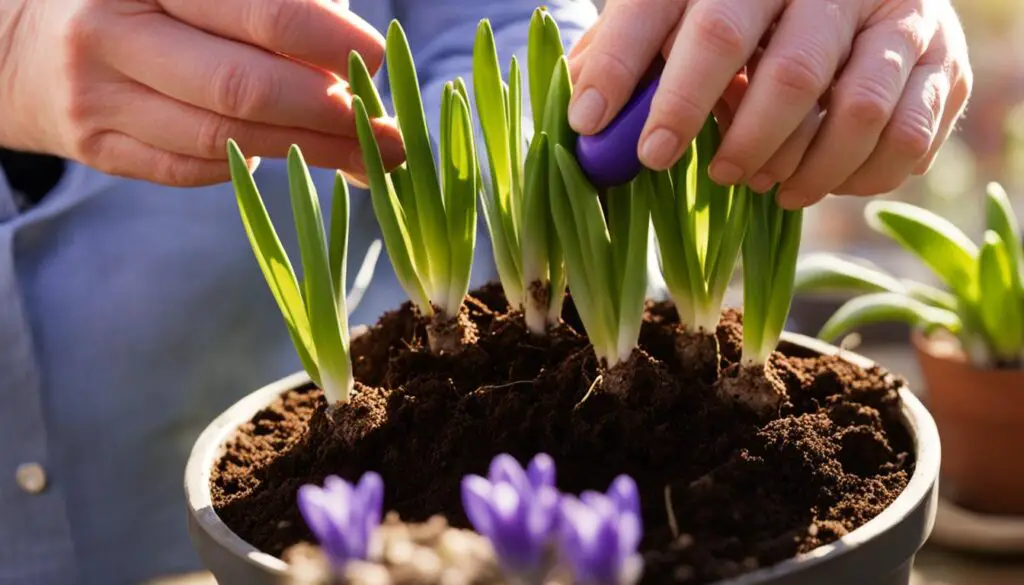
By following these guidelines, you can help your hyacinths grow and bloom beautifully every spring.
Caring for Hyacinth Plants
Keeping your hyacinth plants healthy is key for their blooms to keep coming. Here are some important tips for caring for your hyacinths:
Fertilizing Hyacinths
Give your hyacinths a balanced, bulb-specific fertilizer when they start growing in spring. Use a 10-10-10 formula to help them grow strong and bloom again.
Deadheading Hyacinths
After the hyacinth flowers fade, cut the stalks just above the bulb. But keep the leaves. This helps the plant save energy for next year’s flowers.
Hyacinth Foliage Maintenance
It’s important to care for the leaves of your hyacinths. Let them turn yellow and fully mature before you remove them. They help with photosynthesis and store energy for next year.
Propagating Hyacinths
You can grow new hyacinths by dividing the offset bulbs in the fall. This method takes a few years for the new bulbs to grow big enough to bloom. Growing hyacinths from seed is harder and takes longer, about 3-5 years.
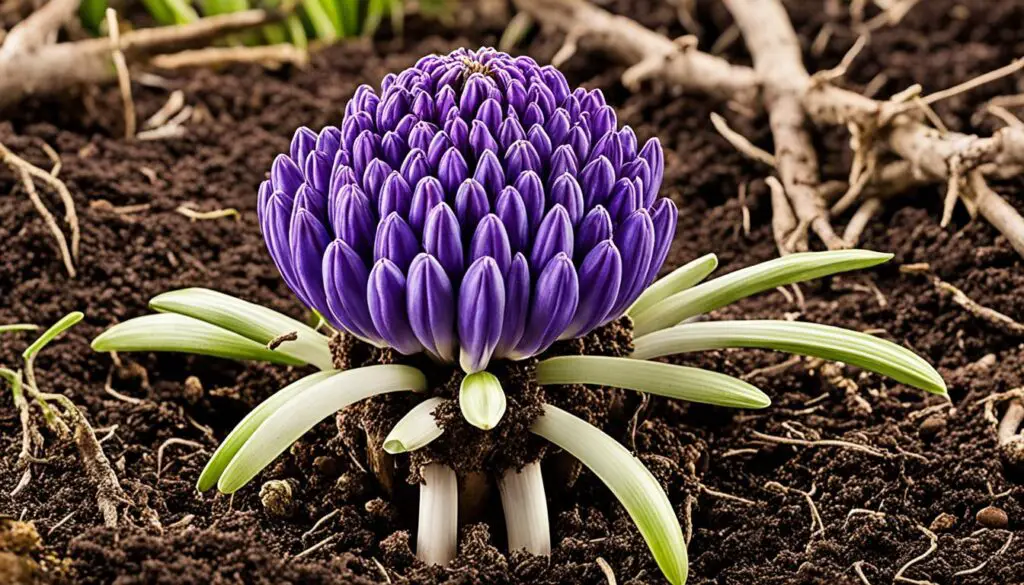
“Hyacinths are a delightful spring-blooming bulb that can be enjoyed for years with proper care and attention.”
By following these tips, you can keep your hyacinths healthy and blooming beautifully every year.
Forcing Hyacinths and Winter Care
As the colder months come, I’m excited to share my tips for forcing hyacinth bulbs indoors. I’ll also cover how to care for your outdoor hyacinth plants during winter. Forcing hyacinth bulbs lets you enjoy their bright colors and sweet smell even when it’s cold outside.
To start, I chill the hyacinth bulbs for 10-12 weeks in a dark, cool spot between 33-45°F. This cold treatment is key for making the bulbs grow roots and shoots. Once they start growing, I slowly introduce them to more light and warmth to help them bloom.
For those growing hyacinths in containers, I move the pots to a sheltered spot or cover them. This prevents the soil from getting too wet during winter.
Outdoor hyacinths may need extra protection in cold areas, like a thick layer of mulch. In warmer zones, I might need to dig up the bulbs, chill them, and then replant them. This ensures they get enough cold.
Pests like aphids, caterpillars, slugs, and snails can harm hyacinths. Fungal diseases like Botrytis blight can also occur in moist conditions. By watching out and giving them the right winter care, I can help my hyacinths grow strong. This way, they’ll bloom beautifully year after year.
FAQ
What is a Hyacinth?
Hyacinths (Hyacinthus orientalis) are bulbs that grow every year. They are part of the Asparagaceae family. They can grow 6-12 inches tall and 3-6 inches wide. They need full sun and soil that drains well but is a bit acidic to neutral.
What are the basic care needs for Hyacinths?
Hyacinths do well in full sun to some shade, needing 6-8 hours of sunlight daily. They like soil that’s a bit acidic to neutral, with a pH of 6.0-7.0. The soil should be loose and drain well to stop the bulbs from rotting in damp, cool spots.
They need about 1/2 inch of water each week, from rain or extra water.
When should I plant Hyacinth bulbs?
Plant hyacinth bulbs in the fall, from October to December. This is about six to eight weeks before the first frost. Put the bulbs in the ground root-end down, 4-6 inches deep, and 3-6 inches apart.
How do I care for Hyacinths after planting?
Feed hyacinths with a balanced, bulb-specific fertilizer when they start growing in spring. After the flowers fade, cut the stalks down to just above the bulb. Let the foliage stay to help the bulb store energy for next year’s flowers.
Can I force Hyacinths to bloom early indoors?
Yes, you can make hyacinth bulbs bloom early indoors. Start by chilling the bulbs for 10-12 weeks in a cool, dark spot between 33-45°F. When roots and shoots start to grow, slowly introduce the plants to more light and warmth to help them flower.
What pests and diseases can affect Hyacinths?
Hyacinths can be bothered by pests like aphids, caterpillars, slugs, and snails. Fungal diseases like Botrytis blight can also hit them in damp conditions. Keeping the soil well-drained and the air around them moving can help prevent these issues.

